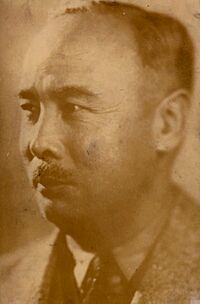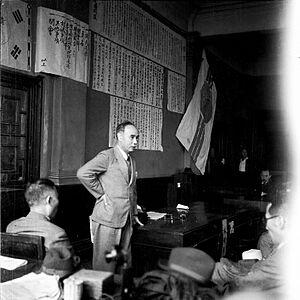Lyuh Woon-hyung facts for kids
Quick facts for kids
Lyuh Woon-hyung
|
|
|---|---|
|
여운형
|
|

Lyuh in May 1947
|
|
| Deputy Minister of Foreign Affairs of the Korean Provisional Government | |
| In office 5 August 1919 – 22 January 1920 |
|
| Chairman of the National People's Representative Conference | |
| In office 14 September – November 1945 |
|
| Preceded by | Position established |
| Succeeded by | Position abolished |
| Personal details | |
| Born | 25 May 1886 Yangpyeong, Gyeonggi, Joseon |
| Died | 19 July 1947 (aged 61) Rotary road, Hyehwa-dong, Jongno-gu, Seoul, Southern Korea |
| Cause of death | Assassination |
| Resting place | Ui-dong, Gangbuk District, Seoul, South Korea |
| Nationality | Korean |
| Political party | People's Party of Korea (1945–1947) Laboring People's Party (1947) |
| Spouse | Jin Sang-ha |
| Children | 9 |
| Parents | Lee (Mother) Lyuh Jung-hyun (Father) |
| Alma mater | Jinling University , Pyongyang Presbyterian Theological Seminary |
| Website | Mongyang Memorial Society |
| Korean name | |
| Hangul |
여운형
|
| Hanja | |
| Revised Romanization | Yeo Unhyeong |
| McCune–Reischauer | Yŏ Unhyŏng |
| Art name | |
| Hangul |
몽양
|
| Hanja | |
| Revised Romanization | Mongyang |
| McCune–Reischauer | Mongyang |
Lyuh Woon-hyung (Korean: 여운형; RR: Yeo Un-hyeong; 25 May 1886 – 19 July 1947) was an important Korean leader. He was also known by his special name, Mongyang. He worked hard to make Korea independent from Japanese rule. He also tried to bring North and South Korea back together.
Lyuh Woon-hyung was a key person in the Provisional Government of the Republic of Korea. This government worked for Korea's freedom when Japan ruled the country. He is special because both South and North Korea respect him.
Contents
Early Life and Education
Lyuh Woon-hyung was born in 1886 in Yangpyeong County, Gyeonggi Province, which was then part of Joseon. His father was Yŏ Chŏng-hyŏn.
When he was about 14, he married Yu Se-yŏng. After she passed away, he married Jin Sang-ha.
In 1900, Lyuh started studying at the Pai Chai School. He later went to other schools like Hŭnghwa School. Around 1907, he joined the National Debt Repayment Movement. This movement was part of Korea's fight for independence. Around this time, he also became a Protestant Christian. He became friends with an American missionary named Charles Allen Clark. This friendship helped him connect with many smart people in Korea.
With Clark's help, he started the Kidok Kwangdong School in 1909. In 1910, Lyuh did something very brave. He freed the slaves that his family owned, which was a big change from old Korean traditions. In 1911, he went to Pyongyang Presbyterian Theological Seminary to study.
Working for Korean Independence
In 1914, Lyuh Woon-hyung traveled to China. He studied English literature at a university in Nanjing. In 1917, he moved to Shanghai. While in China, he became very active in the Korean independence movement.
In 1918, he helped create the Shanghai Korean People's Association. He also led a group called the New Korean Youth League.
In 1919, Lyuh helped write the February 8 Declaration of Independence in Tokyo. This declaration was a very important step before the Korean Declaration of Independence. This second declaration started the huge March 1st Movement protests in Korea. At the same time, he tried to send Korean representatives to the Paris Peace Conference. He hoped they could ask for Korea's independence there.
In April 1919, Lyuh was one of the people who started the Provisional Government of the Republic of Korea. He worked in many different roles in this government. He also started a Korean school in Shanghai called Insŏng School. That same year, he visited Japan and met with important Japanese politicians. He spoke to them about Korea's right to be free.
Political Activities and Challenges
In 1920, Lyuh joined the Korean Communist Party. He was active in its groups in Shanghai and Irkutsk. In 1922, he went to a big meeting in Moscow called the Congress of the Peoples of the East. There, he met famous leaders like Leon Trotsky and Vladimir Lenin. That year, he also helped create the Korean Veterans Association with Kim Ku.
In 1925, he joined the Chinese Nationalist Party and worked to improve relations between China and Korea. In 1929, Japanese police arrested him in Shanghai. He was sent to prison for three years.
In 1932, he was released from prison. In 1933, he became the head of a newspaper called Chŏson Chungang Ilbo. In 1934, he became the head of the Joseon Sports Council.
In 1936, Japanese authorities forced him to leave his newspaper job. This happened after he was involved in the Sohn Kee-chung uniform scandal. In this event, Korean newspapers removed the Japanese flag from pictures of Sohn Kee-chung, who was the first Korean to win an Olympic gold medal. In 1942, he was arrested again and spent time in prison.
After Japan's Surrender
In 1944, Lyuh Woon-hyung knew that Japan would soon lose World War II. He secretly formed a group called the Korean National Establishment Committee. He was its chairman. This group grew across Korea and joined with other Korean nationalist groups.
Just before Japan gave up in August 1945, a Japanese official met with Lyuh. They agreed that prisoners would be released and Japan would leave Korea. On August 17, Lyuh created the Committee for Preparation of Korean Independence. This committee quickly set up over 140 local groups across Korea.
On September 6, 1945, Lyuh announced the creation of the People's Republic of Korea. He became the chairman of its main assembly. However, when the United States arrived in Korea two days later, they did not recognize this new government. In October, Lyuh stepped down under pressure from the United States Military Government. He then formed the People's Party of Korea.
Lyuh tried to bring together different political groups in Korea. He wanted to find a middle ground between the left and right political sides. However, his efforts were difficult because both extreme groups attacked his ideas.
Death
On July 19, 1947, Lyuh Woon-hyung was killed in Seoul. He was shot by a 19-year-old man who was part of a right-wing group. Many people were very sad about Lyuh's death.
Timeline of Key Events
- 1900: Enrolled in the Baejae School.
- 1907: Became a Christian and founded Gwang-dong school.
- 1908: Joined the National Debt Repayment Movement.
- 1914: Went to China and studied English literature in Nanjing.
- 1918: Founded the New Korea Youth Party in Shanghai.
- 1919: Became Deputy of Foreign Affairs for the Provisional Government of the Republic of Korea. Visited Japan to speak about Korean rights.
- 1920: Joined the Koryǒ Communist Party in Shanghai.
- 1922: Participated in a conference in Moscow and met Vladimir Lenin.
- 1929: Arrested by Japanese police in Shanghai and imprisoned for 3 years.
- 1933: Became president of the Chungang Daily News newspaper.
- 1934: Became chairman of the Korea Sports Council.
- 1944: Secretly formed the Korean National Establishment Committee.
- 1945: Met with Japanese officials before Japan's surrender. Formed the Committee for Preparation of Korean Independence. Proclaimed the People's Republic of Korea.
- 1946: Tried to unite left and right political groups in Korea.
- 1947: Assassinated in Seoul.
Images for kids
-
Lyuh Woon-hyung's resting place in Seoul





